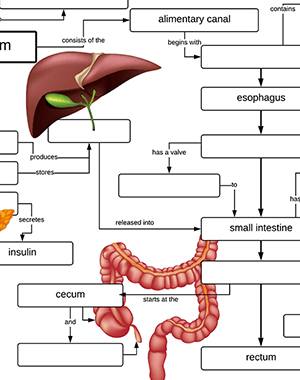
Students use this concept map to reinforce their understanding of the digestive system and how structures within that system are related.
The mouth is where food is chewed and mixed with saliva. Saliva contains enzymes that start to break down food. The esophagus is a muscular tube that connects the mouth to the stomach. The stomach is a muscular sac that churns and mixes food with gastric juices. Gastric juices contain enzymes that break down food even further.
The small intestine is a long, coiled tube that is about 20 feet long. The small intestine is where most of the nutrients from food are absorbed into the bloodstream. The large intestine is a shorter, wider tube that is about 5 feet long. The large intestine absorbs water from food and stores waste products until they are eliminated from the body through the rectum and anus.
Concept Maps as Learning Tools
The map follows the structures of the alimentary canal, like the esophagus, small intestine, and large intestine. It also includes accessory organs like the liver and gallbladder. The map was made for anatomy and physiology students but it could also work for biology or health.
I have concept maps like these for most of the anatomy chapters:
A word bank is included, but you can make the exercise more challenging by removing the word bank. To edit, choose the google doc file from the links below, then choose “make a copy” from the file menu. That will open up a new version of the file on your own google account that you can edit.
Time Required: 10-15 minutes
Grade Level: 6-12
HS-LS1-2 Develop and use a model to illustrate the hierarchical organization of interacting systems that provide specific functions within multicellular organisms

